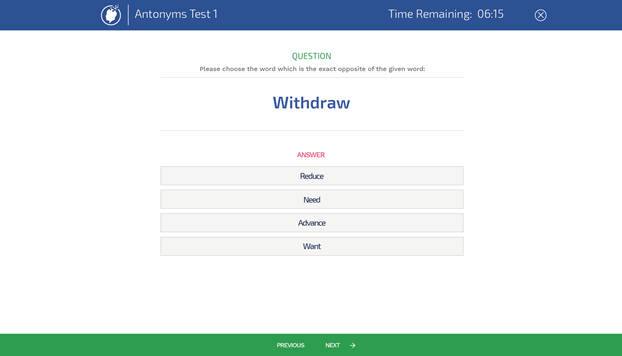- 206 Aptitude Tests
- 3281 Aptitude Test Questions
- One-off Payment
Tips to pass an Antonyms Test
What is an Antonyms test?
Antonym tests may be used by some recruiters to evaluate the vocabulary, knowledge and analysis capabilities of the applicants if needed. The question in the tests may specify words and you may be required to choose an option that will have the opposite meaning of the given word. Multiple probable answer options are usually given for each question one of which is correct. The candidate must figure out the right answer. These tests may also be made use of by some universities for providing admission to various graduate courses.
An example of what an Antonyms test looks like:
You may master antonym tests and perform well following a few tips as mentioned below:
- Watch out for tricky words
Antonym tests may have words that may appear to be related to another word, causing you to infer that the meaning of both the words is similar. Words such as ‘passive’ might appear to be related to ‘pass’ or ‘passable’, and may mislead you into thinking that these convey the same meaning, which is not the case here. Questions consisting of these tricky words appear frequently in antonyms tests. To master the same, you should learn as many of these tricky words as possible. There are both online and offline sources consisting of the commonly used tricky words and can be referred to and used by you for preparing for the antonyms test.
- Use Difficult Words in Sentences
If there is a word whose meaning is difficult to decipher, using the word in a few sentences may help understand the meaning of the word or at least get closer to it. Repetitively using all the given choice options of words in different sentences and reflecting on how they sound may give a vague idea of which words appear to be the most and the least correct. This is usually a better method than outright guessing and marking the answer. During preparation, you may practice and master the antonyms by finding their meaning and trying to make sentences based on the meaning themselves without any help.
- Avoid Answering Instinctively
While appearing for antonym tests, you may answer a question instantly without giving it a second thought or going through it again. You may think that you have practiced that question numerous times before and so the answer for it will be the same. These questions may appear to be quite simple and familiar, but they may have a hidden context that you may not be able to grasp at your first reading attempt.
Every question, no matter how easy or familiar it may look, should be read at least twice before answering it. Reading and re-reading the questions can help you understand it comprehensively and find out if there is any underlying meaning conveyed in the sentence that might have been overlooked in the first time.
- Eliminate Least Relevant Answers
While answering a question, you can arrive at the right answer by eliminating the least relevant answers first. All the given answer choice should be analyzed by you to determine their respective antonyms. The answers whose antonyms are uncertain or vague in the context of the question can be eliminated. This can help narrow down the result and find a correct answer faster than usual.
Another elimination technique that may be used by you is finding synonyms in the answer choices. The multiple answer options given might have words with the same meaning. Since there are two words that can be used in the same situation, these will not be correct because the given question will only have a unique answer. Therefore, the words that have a similar meaning can be eliminated.
- Analyze Word Root and Determine Word Charge
Knowing the root of a word may help determine the meaning of the word. For example, the words ‘amicable’ and ‘amenable’ may have a meaning in the same context i.e. friendliness and openness. Learning the most common root words by heart may help determine the meaning of any unfamiliar words that you might encounter in the test.
A word that sounds or appears to be used in a positive context, is said to be positively charged and a contrary context reflects a negatively charged word. The word “benevolent” has a positive charge and it denotes goodness while the word “malicious” is negative and denotes hostility.
If a question has the word “unkind” which is also negatively charged, it cannot be the antonym of another negatively charged word and hence the word “malicious” can be rejected, leaving the positively charged word “benevolent” as the right answer.
Root words may also help determine the charge on a word. For example, the root word ‘mal’ is used in a negative context, such as in ‘malnutrition’ and hence is negatively charged. All words that might begin with ‘mal’, whether familiar or unfamiliar, will be negatively charged.
- Increase Vocabulary
As antonym tests are mainly based on words, the performance of you will depend on your vocabulary. The more words you know, the more will be your chances of getting a good score in the test. Therefore, you should make efforts to learn new words and increase your knowledge base. Reading new books, especially fiction and novels that are rich in new words may help you add words to your vocabulary. Reading is a better approach than cramming words, as using words in sentences aids you understand their meaning as well as the context of their usage. This can be quite helpful at the time of the test, as you may try to decipher the meaning of words by making use of them in sentences.
- Practice Regularly
The best way to pass a test and score well in it is regularly preparing and practicing for it. By reading texts and trying to formulate sentences and speaking them out aloud, you can prepare yourself well for the antonyms test. Regular practice can also help curb the instinctive answering tendencies of you.
How can Assessment-Training.com help you ace your Antonyms test?
Assessment-Training.com is your number 1 online practice aptitude test and assessment provider. Our aim is to help you ace your assessment by providing you practice aptitude tests that mimic the tests used by employers and recruiters. Our test developers have years of experience in the field of occupational psychology and developed the most realistic and accurate practice tests available online. Our practice platform uses leading-edge technology and provides you feedback on your scores in form of test history, progress and performance in relation to your norm group.
Check out our tailor-made Antonyms Test Pack to fully prepare you for your assessment.
The Assessment-Training.com data science team found that through practice, candidates increased their scoring accuracy and went into their assessments more confident. Remember, you need to practice to make sure you familiarize yourself with the test formats, work on your accuracy and experience performing under time-pressure.
Antonyms
- 5 Tests
- 75 Questions
- One-off payment
- 206 Aptitude Tests
- 3281 Aptitude Test Questions
- One-off Payment
Antonyms
- 5 Tests
- 75 Questions
- One-off payment

